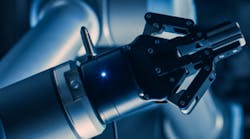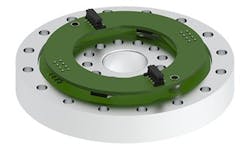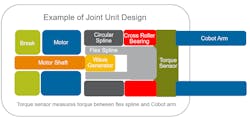From Robots to Cobots: The Growing Role of Cobots in Factory Automation
Cobots are smaller, cheaper, and easier to program than traditional industrial robots, while also providing increased flexibility. They can be quickly reassigned to perform new tasks as needed or easily moved to a different area of a factory or warehouse. Most importantly, Cobots are also designed to operate safely alongside people, making them well suited for dangerous, unpleasant or repetitive tasks, or to assist human operators in tasks that require extreme precision.
TE Connectivity (TE), one of the world’s largest sensors providers, has a pulse on the use of cobots in factory automation and is focused on key trends shaping the future such as increased flexibility, lower total cost of ownership, enhanced safety, and durability.
As a Product Manager for Force and Torque Sensors at TE Connectivity, I've seen firsthand that collaborative robots are one of the most rapidly growing segments of the robotics industry.
While cobots are relatively new, with the first commercial cobots only hitting the market in 2008, their sales saw a significant uptick when the global pandemic struck. Beginning in late 2019 and early 2020, demand for cobots began to soar.
I believe that demand was spurred by a number of factors, not the least of which was the need to keep production lines running when the availability of workers was drastically reduced.
There was a need for automation to fill the gap left by the large number of people who were not available to come into the factory. And since there was no telling when the pandemic would ease, many companies quickly adopted cobot technology to keep their production lines running.
According to the International Federation of Robotics (IFR), 22,000 cobots were installed in 2020, twice as many as were deployed in 2017.
As for future growth, ABI Research predicts that by 2026, worldwide cobot shipments are expected to pass 47,000 annually.
As sophisticated sensors have helped to make cobots safer when interacting with humans, companies have become more trusting of them. This has expanded the types of applications for which cobots can be utilized. I expect to see double-digit growth for cobots through the next decade.
The benefits of cobots over industrial robots are simply that cobots offer a quicker set-up, are much more flexible, and do not require the traditional physical parameters that are required with industrial robots. They also come at a much lower price point than industrial robots, making them more affordable to purchase and operate.
While physical barriers around industrial robots, such as fencing, are necessary to prevent injuries to humans, cobots do not require these types of barricades. This means that cobots can operate in a variety of workspaces where automation was previously not possible. Cobots can be safely placed in the same workspace with humans, interacting with and working alongside them.
Cobots also offer ease of use. In contrast to a stationary industrial robot, they can be easily moved around or relocated to accommodate the needs of the production line or factory floor. Cobots are relatively simple to deploy and offer a fast setup. Programming is very simplistic. Cobots don’t require significant coding or automation experience.
Another key advantage to the cobot is increased productivity. Cobots can be placed in complex, dangerous or unpleasant work environments, where humans are unable or do not want to perform tasks, such as interacting with chemicals or working in extreme conditions of heat or cold.
What’s more, cobots can increase return on investment (ROI) and productivity while reducing labor costs.
However, the notion of cobots replacing employees is not really the case. Employees who used to perform a certain task are now programming and maintaining a cobot that will do the work for them, so their jobs have become more enriching as well as safer and more enjoyable.
As a product manager, I have a unique pulse on the operational aspect of cobots, especially the sensors used within the device. Sensors are a key component of cobots as they are used to monitor and control the precise movements of the cobot as well as monitor critical components to prevent system failures and allow for predictive or preventive maintenance.
TE Connectivity produces sensors that help cobots to operate safely, accurately, and efficiently. As companies look to incorporate cobots into more shared working spaces with employees, safety and performance are crucial. TE sensors vastly improve both safety and performance. The improved functionality that these sensors provide increases users’ comfort level with placing cobots in the same work environment as humans.
TE manufactures a multitude of sensors including performance, safety, optical, and pressure sensors. The need for specific sensors is dependent on the end application; the environment in which the cobot will operate dictates the specific sensor features.
For example, one key sensor that TE produces is the joint torque sensor, which improves both safety and precision of the cobot. This sensor monitors the mechanical torque applied at the joint or at the pivot point of the cobot, translating the mechanical force into a digital output that monitors collision detection. If an imminent impact with a human or any object is sensed, the joint torque sensor immediately shuts down the cobot. The joint torque sensor offers higher accuracy and higher resolution of the cobot arm movement, including precise angular positioning.
The joint torque sensor improves response and accuracy of position during manual arm guidance or teaching mode.
I foresee the trend of heavier payloads and increased application uses for cobots: As cobots are being deployed in new applications, we are seeing a need for increased payload ranges, faster arm speeds, higher efficiency, and expanded working envelopes (the area in which a robot can move around).
The cobots are being programmed to handle more steps in the production of a good or material. Users are also employing them to grasp larger components than previously needed.
At TE Connectivity, we strive to stay ahead of the curve by constantly improving sensor technology to handle higher payloads without sacrificing accuracy.
As for the future of cobots, they're the most dynamic segment in robotics at this time. At TE, we are excited to support the expanded use of cobots in new applications and help to improve safety and productivity.













